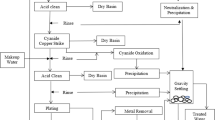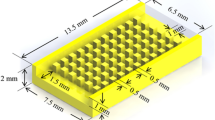Abstract
Enhancement in the heat removal from hot water co-flowing in a mini-channel in a direct contact manner with two liquid metals, gallium and mercury, is investigated numerically. Results show that the liquid metals lead to superior heat removal from hot water co-flowing in the channel as compared to the case when only water flows in the channel. Moreover, it is found that gallium yields higher heat removal from water than mercury by about 15 %. This percentage, representing the superiority of gallium over mercury increases to about 20 % under conditions when the mass flow rate of both the liquid metal and the co-flowing water are doubled. The results reported showed numerical mesh independence. However, the results show much dependence on the spatial discretization scheme adopted where it is found that first order upwind scheme yields somewhat over predicted heat exchange rates in the channel, as compared with the case when a second order scheme is used. It is found further that the channel efficiency in removing heat from the water is remarkable in the first half of the overall channel length where in general the heat removed in the first 10 mm of the channel length is found to be about 70 % of the total heat removed. This percentage is a bit less than that when only water flows in the channel.








Similar content being viewed by others
References
Al Omari S-AB (2011) Enhancement of heat transfer from hot water by co-flowing it with mercury in a mini-channel. Int Commun Heat Mass Transf 38(8):1073–1079
Bar-Cohen A, Kraus AD, Davidson SF (1983) Thermal frontiers in the design and packaging of microelectronic equipment. Mech Eng 105(6):53–59
Incropera FP (1988) Convection heat transfer in electronic equipment cooling. ASME J Heat Transf 110:1097–1111
Yeh LT (1995) Review of heat transfer technologies in electronic equipment. J Electron Packag 117:333–339
Sathe S, Sammakia B (1998) A review of recent developments in some practical aspects of air-cooled electronic packages. ASME J Heat Transf 120:830–839
Chomdee S, Kiatsiriroat T (2006) Enhancement of air cooling in staggered array of electrical modules by integrating delta winglet vortex generators. Int Commun Heat Mass Transf 33:618–626
Tsai T-E, Wu H–H, Chang C–C, Chen S-L (2010) Two-phase closed thermosyphon vapor-chamber system for electronic cooling. Int Commun Heat Mass Transf 37:484–489
Wits WW, Vaneker THJ, Mannak JH, Legtenberg R (2009) Novel cooling strategy for electronic packages: Directly injected cooling. CIRP J Manuf Sci Technol 1:142–147
Liu S, Zhang Y, Liu P (2007) Heat transfer and pressure drop in fractal micro channel heat sink for cooling of electronic chips. Heat Mass Transf 44(2):221–227
Deng Y, Liu J (2009) Hybrid liquid metal-water cooling system for heat dissipation of high power density micro devices. Heat Mass Transf 46(11–12):1327–1334
Farsad E, Abbasi SP, Zabihi MS, Sabbaghzadeh J (2011) Numerical simulation of heat transfer in micro channel heat sinks using nanofluids. Heat Mass Transf 47(4):479–490
Al Omari S-AB, Haik Y, Abu Jdayil B (2010) Flow characteristics of gallium in a meso-scale channel under the influence of magnetic fields. Int Commun Heat Mass Transf 37(8):1127–1134
Al Omari S-AB (2011) Characteristics of the flow and heat transfer of gallium in a mini-scale channel under the effect of magnetic field. J Enhanced Heat Transf 18(6)
Ma K-Q, Liu J (2007) Nano liquid-metal fluid as ultimate coolant. Phys Lett A 361:252–256
Dumont G, Fontaine Vive Roux Ph, Righini B (2000) Water-cooled electronics. Nucl Instrum Methods Phys Res A 440:213–223
Incropera FP (1999) Liquid cooling of electronic devices by single-phase convection. Wiley, Hoboken
Naphon P, Wiriyasart S (2009) Liquid cooling in the mini-rectangular fin heat sink with and without thermoelectric for CPU. Int Commun Heat Mass Transfer 36:166–171
Nguyen CT, Roy G, Gauthier C, Galanis N (2007) Heat transfer enhancement using Al2O3–water nanofluid for an electronic liquid cooling system. Appl Therm Eng 27:1501–1506
Kwang-Soo K, Myong-Hee W, Jong-Wook K, Byung-Joon B (2003) Heat pipe cooling technology for desktop PC CPU. Appl Therm Eng 23:1137–1144
The CFD package Fluent 6.3
Kothe DB, Rider WJ (1995) Comments on modeling interfacial flows with volume-of-fluid methods, Los Alamos National Laboratory Report, Classification index numbers: 65P05, 76T05
Noh WF, Woodward PR (1976) SLIC (Simple Line Interface Method), In: Van De Vooren AI, Zandbergen PJ (eds), Lecture Notes in Physics 59, pp 330–340
Hirt CW, Nichols BD (1981) Volume of fluid (VOF) method for the dynamics of free boundaries. J Comput Phys 39:201–225
Youngs DL (1982) Time-dependent multi-material flow with large fluid distortion, In: Morton KW, Baines MJ (eds), Numerical methods for fluid dynamics, pp 273–285
Muzaferija S, Peric M, Sames P, Schellin T (1998) A two-fluid navier-stokes solver to simulate water entry, In: Proceedings 22nd symposium on naval hydrodynamics, pp 277–289, Washington, DC
Author information
Authors and Affiliations
Corresponding author
Rights and permissions
About this article
Cite this article
Al Omari, SA.B. A numerical study on the use of liquid metals (gallium and mercury) as agents to enhance heat transfer from hot water in a co-flow mini-channel system. Heat Mass Transfer 48, 1735–1744 (2012). https://doi.org/10.1007/s00231-012-1015-9
Received:
Accepted:
Published:
Issue Date:
DOI: https://doi.org/10.1007/s00231-012-1015-9




